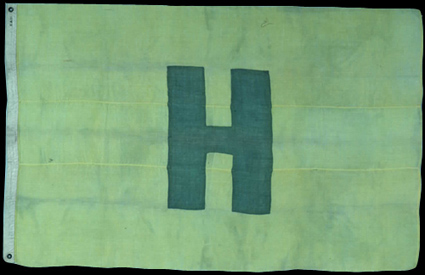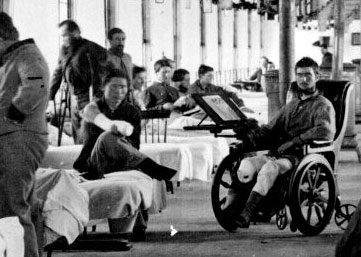
The yellow and green hospital flag
During the Civil War there were many advances made in medical treatment. Often through trial and error surgeons discovered new methods to treat patients and more effective methods of care. Treatment was not the only area of medicine that advanced however, the use of military hospitals was drastically changed during the Civil War and set a precedent for military hospitals through World War II.

the original solid red hospital flag
There were several ways in which a hospital could be arranged during the civil war. They generally fell into two categories, field hospitals and fixed general hospitals. At the beginning of the war armies would find abandoned buildings near the edge of the battlefield and convert them into field hospitals. These, however, were often poorly ventilated and unsanitary. As the war progressed, and particularly after the Battle of Shiloh in 1862, the buildings were often left in favor of tents which could be easily arranged and moved at will. The standard hospital tent could comfortably fit eight beds and could be joined to other tents in order to make larger hospitals. These tents were well-ventilated which aided in dispersing the stench of pus and gangrene. Heating methods were also invented to keep the tents at a workable temperature. Separate tents were also set up in order to isolate patients with highly contagious diseases such as gangrene and smallpox. This helped to curb the spread of these deadly diseases and saved many lives. The tents were originally marked with solid red flags but these were abandoned in favor of yellow flags with a green H (Dammann 113).
Field hospitals changed drastically over the course of the war, not only from tents to buildings but also in size, staff, and many other respects. Originally field hospitals were broken down into regimental tents. These tents usually had one surgeon and one assistant surgeon who would only treat soldiers from their assigned regiment so that one tent was not overwhelmed with casualties. This meant that a soldier could be turned away from a tent and be forced to search for the proper tent while losing precious time (54).
In 1862, Jonathan Letterman was assigned the post of Medical Director of the Army of the Potomac and undertook to fix the flaws in the current medical system. By late 1862 he had completely abolished regimental hospitals and replaced them with divisional hospitals. These hospitals were larger and situated farther back on the battlefield in order to move them out of firing range. The staff generally consisted of a surgeon-in-chief, three operating surgeons, nine assistant surgeons, a medical officer, and a variety of soldiers to perform the various duties of nurses and stewards (54).
Each divisional hospital was paired with mobile field units which were set up on the battlefield to retrieve wounded soldiers. These mobile units were easily broken down and set up wherever they were needed making it much easier to administer emergency care. The mobile units made decisions from administering opiates to determining whether a soldier was beyond saving or should be transferred to the divisional hospital.
These field hospitals were not the only advances made though. Permanent hospitals were also put in place in the cities for longer term patients. Designed by Dr. John Shaw Billings, these hospitals were made of wood and built like pavilions and were generally 150 feet long, 25 feet wide, and 12 to 14 feet high. They fit about sixty beds and fitted with a large amount of windows in order to help with ventilation, a design suggestion by Florence Nightingale. The units were arranged in rows or columns and surrounded the central facility in either an arc or a grid. Records indicate that 431 of these hospitals were built, although there were probably no more than 204 in operation at one time (114).

A group of wounded soldiers
Over two million soldiers, confederate and union, were treated in the hospitals during the civil war. Records show that of the one million union soldiers treated less than ten percent died. The confederate numbers are similar but their method of tracking makes them unreliable (112). This was due in part to the advances made in facilities and treatments, but it was also due to the men and women who served in the hospitals.
Women played a very important role in the war, although they were often overlooked. Having been barred from the medical profession due to a perceived lack of strength, both physical and mental, women took on the role of nurse in the hospitals. Nurses were generally attached to either a hospital, where they performed medical duties, or a regiment where they performed both medical and field duties. These could include taking care of livestock, cooking and serving, cleaning weaponry, and any other tasks needed (Schultz 371).
Women were often looked down upon in the hospitals, and the selection process required that nurses be “over thirty, plain looking, and devoid of curls, bows, and hoopskirts” (Schultz 366). Women were often considered to be a distraction and incapable of performing as well as men. One man however fought for women to b placed in hospitals. His name was Surgeon General William Hammond and he maintained that women were more docile and efficient than men and were able to better lift morale. However, given his, at the time, unorthodox practice of gentle healing he was considered to be not credible and therefore women’s strongest ally in the field was unable to aid them in a way that would have benefited them (372).
Although women were at the bottom of the hierarchy the male surgeons were also faced with a complicated hierarchy. Originally, surgeons were only able to rise to the rank of major surgeons were often outranked in their own hospitals, and therefore required to obey orders against the best interest of the patient. This hierarchy was the cause for many problems in the hospitals. Often the chain of command was unclear, leaving nurses unable to receive the aid, instruction, and supplies they needed. This hierarchy also manifested itself in a sense of corruption among those higher up in the chain, particularly the men. Schultz tells of how Phoebe Pember was forced to sit silently by as she watched surgeons and male nurses leave the hospital to get drunk and then doctor each other’s report to cover up the absences (374).
However, although there were many problems with both the staff set up and the hospital arrangement the numbers of people saved still stand. Although one of the bloodiest wars in history, the Civil War was a time of great advancement for the medical community; standards set in this war would stand for many years to come, influencing the ways in which military patients were cared for long into the future.
Works Cited
Schultz, Jane. 1992. “The Inhospitable Hospital: Gender and Professionalism in Civil War Medicine.” Journals of Women in Culture and Society. Vol. 17. No. 2. Pgs. 364-392.University of Chicago. Chicago, IL.
Dammann, Gordon and Alfred J. Bollet. 2008. Images of Civil War Medicine: A Photographic History. Demos Medical Publishing. New York, NY.
First photograph. visit-gettysburg.com. <http://www.visit-gettysburg.com/images/civil-war-hospital-flag.jpg>
Second photograph. Jen G’s Blog. <http://jlgarrott.blogs.wm.edu/files/2009/07/flag-4.JPG>
Third Photograph. historyforkids.org. <http://www.historyforkids.org/learn/northamerica/after1500/history/pictures/civilwarwounded.jpg>



